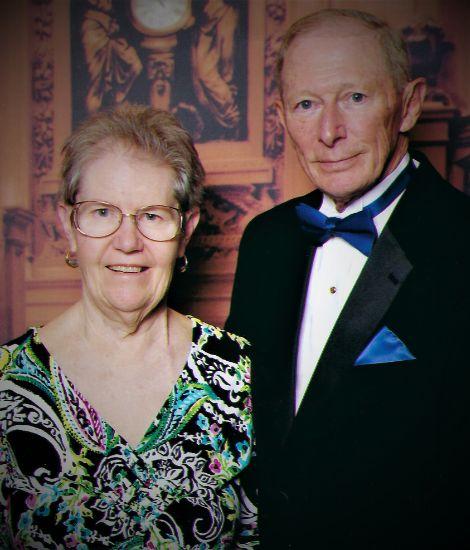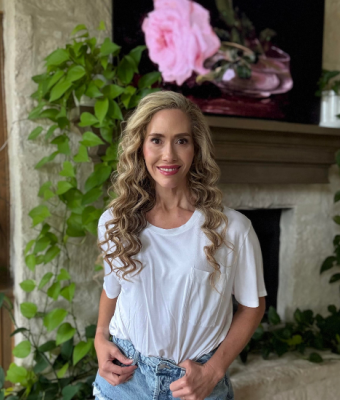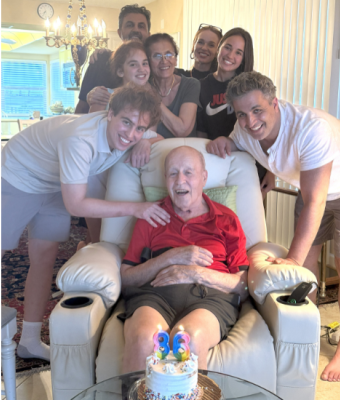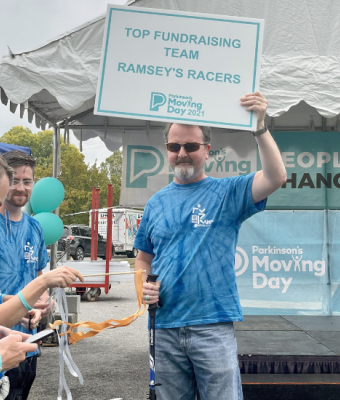My PD Story

Edmund and Jane
Our story begins in early 1997, when Jane’s bank rejected a check she had written, claiming the signature did not match the one on file. Her handwriting had become unreadable. She had also noticed that when she walked, her dominant arm did not swing, but instead came up by itself and rested stiffly across her stomach. Jane’s primary care physician ran imaging tests to rule out structural problems in her hand. None found, he referred her to a movement disorder neurologist.
The neurologist observed slowness and stiffness in her movement (bradykinesia) and impaired fine coordination in her hand. She received a tentative diagnosis of Parkinson’s disease. Jane was put on carbidopa/levodopa for a 3-month trial, and her symptoms improved. After her Parkinson’s diagnosis was confirmed, Jane’s neurologist changed her therapy to a dopamine agonist, which was to be her drug of choice for the next seven years. Jane’s neurologist did not give her any literature or education about the disease. Since she did not know anyone who had Parkinson’s, the diagnosis did not upset her. As far as she was concerned, a little handwriting problem and her right-arm action when she walked had little impact.
Jane and I had known each other for many years. She was part of my extended family, dating back to when she was in college. In 1998, I decided to retire from my career as a scientist and engineer. I called Jane up one day and told her that I and my Siamese cat, Nefertiti, were going to board my 38-foot powerboat and travel down the Intracoastal Waterway to the west coast of Florida, where we would spend the winter. I asked her if she would like to come. She said yes. We have been together ever since.
For the next six years, we had a great life. We settled in Florida and built a home in the waterfront community of Punta Gorda Isles. Jane established a relationship with a local neurologist, whom she saw periodically. All was well until 2005, when Jane began to experience additional Parkinson’s symptoms. She gained significant weight. She was unable to get a good night’s sleep. During the day, she would suddenly fall asleep, even when talking with someone, waking 10 or 20 seconds later as if nothing had happened. She could hardly get around, even with a walker. Getting out of a chair required assistance. She was also exhibiting tremors in her hands and feet. The situation was not looking good, but everything was about to change because of our self-motivated effort to learn more about Parkinson’s disease.
In October 2005, we went to a Parkinson’s seminar. Our initial interest was to learn about deep brain stimulation (DBS). However, one of the physicians who spoke discussed the various classes of drugs used to treat the disease, and their side effects. He also spoke of the need for drug therapy to change as the disease progresses. As we drove home, I told Jane, “Make an appointment, we need to talk to your neurologist.” Jane’s neurologist discontinued her use of a dopamine agonist. Six months later, she had her life back! She returned to her normal weight and her sleeping problems subsided. She no longer needed to use a walker. The tremors and stiffness were still there but otherwise, life was good. I later learned that some people on dopamine agonist therapy develop compulsive behavior – Jane’s compulsion had been buying fabric, more than she would ever use in a lifetime. With Jane no longer on a dopamine agonist, the fabric purchases stopped!
We had recovered from the brink of needing to find Jane a nursing home, all because we became proactive, educated ourselves and were insistent that Jane’s medical professionals consider changes in her therapy. The changes in the drug therapy eliminated the side effects that were prevalent in 2005, but they did not stop the progression of the disease. By the end of 2006, Jane started experiencing freezing of gait, increased slowness of movement and tremor. Jane could no longer get onto and off a small boat. We sold our boat, but we could not stay away from being on the water. Our solution was to go on cruise ships, from the large ocean-going liners to the smaller inland river boats.
In March of 2010, Jane received her first deep brain stimulation device. She calls the operation a “no brainer,” as there was no pain associated with the surgery or post-surgery. The result was spectacular. Tremors were essentially gone on the right side of her body. Involuntary movements called dyskinesia, which can be a byproduct of Parkinson’s medications, were greatly reduced. We were so pleased with the result of the surgery that a second DBS device was placed in early 2011, which improved symptoms on both sides of the body.
Despite symptom improvements from DBS, freezing of gait soon began to lower Jane’s quality of life. She did not want to go anywhere. She felt like her feet were glued to the floor. I had read that freezing can sometimes be broken by use of a triggering device, so one morning, I went into my shop and built something I thought might help. Jane called it her “launcher,” and she carried it everywhere she went. We also tried different scooter options for longer walks.
A breakthrough in Jane’s treatment came in 2014. While attending a support group, we learned about Parkinson’s Foundation Centers of Excellence. There was such a place for Parkinson’s disease only a three-hour car drive from our home. Jane met with a movement disorder neurologist, Dr. Michael Okun, who set up a comprehensive treatment plan. This plan is updated every six months and has changed our lives for the better.
During 2017 and 2018, we gained even more experience managing the disease. Jane suffered several falls, one of which put her in the hospital for three days followed by an additional seven days of rehabilitation in a nursing home. Other treatments included voice therapy, physical therapy, occupational therapy and multiple sessions with a psychologist. We later moved to The Villages, Florida to be closer to the Norman Fixel Center for Neurological Diseases, a Parkinson’s Foundation Center of Excellence.
Jane and I have gained 25 years of first-hand experience with Parkinson’s disease. Our support group, recognizing that we had learned a lot about Parkinson’s disease and its treatment, asked us to give a talk about our experiences. The word got out and soon we were speaking to support groups on the west coast of Florida and eastern Tennessee, as well as impromptu small gatherings on cruise ships. Every Parkinson’s journey is different, but our individual journeys all have similarities, so there is much to learn from each other.
Learn more about the Parkinson’s Foundation Global Care Network and find a Center of Excellence near you.
Related Materials
More Stories
from the Parkinson's community


